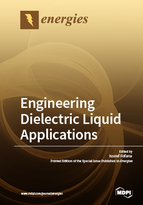Engineering Dielectric Liquid Applications
A special issue of Energies (ISSN 1996-1073).
Deadline for manuscript submissions: closed (30 April 2018) | Viewed by 50427
Special Issue Editor
Interests: Electromagnetic compatibility; Electrical engineering; Electrical insulation; Dielectric materials; Problems associated with the transport and distribution of electrical energy
Special Issues, Collections and Topics in MDPI journals
Special Issue Information
Dear Colleagues,
Insulating liquids are used for impregnating solid insulations or filling products of very large number of electric materials. Several billion liters of insulating liquids are used worldwide in equipment such as transformers (power, rectifier, distribution, traction, furnace, potential, current), resistors, reactors, capacitors, cables, bushings, circuit breakers, tap changers, thyristor cooling in power electronics, etc. Their role is paramount in the sense that it is one of the fundamental conditions for the proper functioning of these equipment. Similar to blood in human body, the insulating liquid keeps responsibility to the entire equipment. The greatest challenges are related to the need for methods to assess the condition along with the improvement of the fluids efficiency by chemical admixtures and or application of biodegradable fluids.
The Special Issue will cover theoretical and practical developments with special emphasis on engineering problems in using these liquids in electrical equipment. The applications of new fluids and perspectives are also concerned.
Topics of interest for publication include, but are not limited to:
- Application and performance of dielectric liquids
- Electro-hydrodynamic phenomena and related applications
- Breakdown and pre-breakdown phenomena,
- Electrostatic charging tendency
- Insulating liquids efficiency improvement by chemical admixtures
- Nanofluids and synthetic/vegetable dielectric liquids
- Measurement, monitoring and diagnostic techniques
- Fundamental investigations and basic properties
Prof. Dr. Ing. Issouf Fofana
Guest Editor
Manuscript Submission Information
Manuscripts should be submitted online at www.mdpi.com by registering and logging in to this website. Once you are registered, click here to go to the submission form. Manuscripts can be submitted until the deadline. All submissions that pass pre-check are peer-reviewed. Accepted papers will be published continuously in the journal (as soon as accepted) and will be listed together on the special issue website. Research articles, review articles as well as short communications are invited. For planned papers, a title and short abstract (about 100 words) can be sent to the Editorial Office for announcement on this website.
Submitted manuscripts should not have been published previously, nor be under consideration for publication elsewhere (except conference proceedings papers). All manuscripts are thoroughly refereed through a single-blind peer-review process. A guide for authors and other relevant information for submission of manuscripts is available on the Instructions for Authors page. Energies is an international peer-reviewed open access semimonthly journal published by MDPI.
Please visit the Instructions for Authors page before submitting a manuscript. The Article Processing Charge (APC) for publication in this open access journal is 2600 CHF (Swiss Francs). Submitted papers should be well formatted and use good English. Authors may use MDPI's English editing service prior to publication or during author revisions.
Keywords
- electrical discharge
- dielectric phenomena
- electro-hydrodynamics
- biodegradable fluids
- nanofluids
- aging and degradation
- diagnostic and monitoring
- high voltage direct current (HVDC) applications






